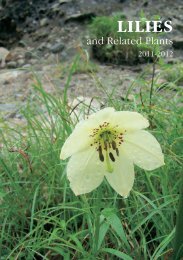LILIES - RHS Lily Group
LILIES - RHS Lily Group
LILIES - RHS Lily Group
Create successful ePaper yourself
Turn your PDF publications into a flip-book with our unique Google optimized e-Paper software.
In many ways the Newsletter is the most important publication of the <strong>Lily</strong><br />
<strong>Group</strong> as it is the main point of contact with members. To be effective it has to<br />
be informative, well written, and sent out at set times of the year – something to<br />
be eagerly awaited. Tony’s newsletters were all of those things: they were, by<br />
common consent, the best that members had ever enjoyed.<br />
With the rapid growth in membership in the 1980s it became apparent that the<br />
Secretary’s duties had become too burdensome for one person and would have<br />
to be divided. Thus, Tony also became the first Membership Secretary in 1988,<br />
continuing until 1998 when he retired from the Committee. His first task was to<br />
take over the computerized membership records that the Secretary had set up a<br />
few years previously, and transfer them to the <strong>Lily</strong> <strong>Group</strong>’s own new computer.<br />
That same year he was also greatly involved with the organisation of the Fritillaria<br />
Conference (the genus particularly interested him) held at the Chelsea Physic<br />
Garden. And also, that same year, he moved house from the hurly-burly of<br />
suburban Epsom to the rural tranquillity of Lowbands in Gloucestershire.<br />
The following year he also took on the editorship of Lilies and Related Plants<br />
(the <strong>Lily</strong> Year Book), producing three splendid issues commencing with the<br />
Proceedings of the 5th International <strong>Lily</strong> Conference in 1989.<br />
There were three strands to Tony’s life: his family; his work (teaching and<br />
research); and gardening (including competitive showing, lecturing and editing<br />
books). His catch phrase was “Make a difference!” He was quiet, thoughtful and<br />
attentive to detail - ideal qualities for the particular tasks that he undertook and<br />
so ably carried out. But, although undemonstrative by nature, he would plainly<br />
speak his mind when he thought it necessary. It was the <strong>Lily</strong> <strong>Group</strong>’s good<br />
fortune to enjoy his many contributions to its work for so long.<br />
Throughout his life Tony loved sharing his knowledge through giving talks.<br />
These were always delivered extempore and, when his memory started to fail,<br />
rather than use notes he gave up lecturing altogether. He died in January 2006<br />
– ironically not from Altzheimer’s disease but from mesothelioma, probably<br />
contracted during the refurbishment of one of the many hospitals in which he<br />
worked. He is survived by Barbara, a son and two daughters.<br />
Dr Anthony Frederick Hayward, anatomist and plantsman<br />
Born 27 December 1933, died 16 January 2006 aged 72<br />
57




